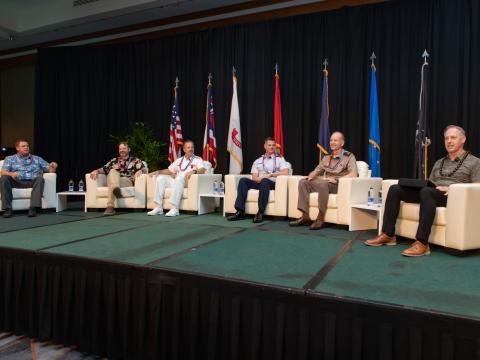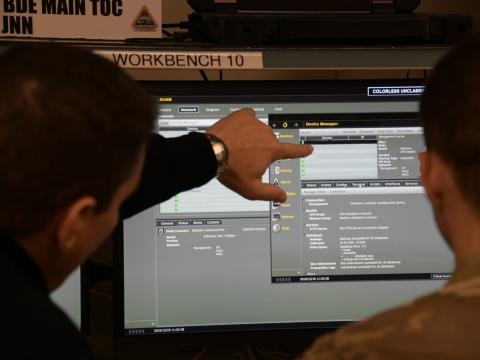Alert Module Links Remote Facilities
Monitoring apparatus creates unified diagnostic picture.
U.S. Army communications facilities in Okinawa, Japan, are using an automated alarm management system to monitor legacy equipment that is not interoperable. Consisting of an easily installed remote unit and management software, the system permits administrators to control multiple proprietary devices from a single on-screen interface.
Military bases and government buildings often host a mix of systems. Much of this hardware consists of stovepiped alert and diagnostic functions that cannot interoperate with commercial management software. Coordinating the smooth operation of network applications is as vital to the viability of key infrastructures as are firewalls and intrusion detection systems. A package that permits the administration of these different functions offers users the potential for maintenance and cost savings.
According to John Thompson, a project leader with the U.S. Army Communications-Electronics Command’s Worldwide Technical Control Program, Fort Monmouth, New Jersey, communications and logistics facilities on Okinawa were using an aging alarm system that was not meeting the service’s needs. “It was limited to only one alarm system report. We were in the position where we had to replace the alarm system with something more modern, and something that was obviously more robust,” he explains.
The Army chose Intelligent Systems Management (ISM) products to manage its Okinawa communications facilities because of ISM’s automated features. Many sites are located on remote mountain tops that can take repair teams up to four hours to reach. The equipment had been installed in more than 18 facilities across the island by late spring.
Manufactured by Teltronics Incorporated, Proctorville, Ohio, the ISM module is a transmission alarm system designed to provide equipment failure and status alerts for a variety of equipment such as servers, communications and power systems. An on-site remote monitoring box, the Site Event Buffer Enterprise Agent (SEBea) contains serial and network interfaces that are compatible with a variety of protocols. “We can hook this thing up to just about everything from environmental alarms as well as many of the legacy systems that are SNMP [simple network management protocol],” Thompson says.
Proprietary, stovepiped alarms are collected together into an SEBea box that transmits the collected alarms to a central control room via a radio signal or fiber optic line. This data is compiled on a computer at the main control facility and administered by Teltronics’ IRISnGEN 2.0 management software that displays the information on a graphic user interface.
The IRISnGEN software features an escalation function. If no action is taken, the alarm system can be set to notify progressively higher-ranking personnel such as supervisors or managers. Many ISM features can be set to operate automatically or manually, depending on user requirements.
A challenge faced in Okinawa was integrating ISM equipment into existing alarms because they consist of proprietary, stovepiped systems. Thompson notes that it is not necessary to replace all of these legacy devices, but to place them in an overarching network that can provide operators with a single operational picture. “What we’re trying to do is bring as many systems as possible into a single alarm management system,” he offers.
The operating environment presented several unique requirements. Because the island is in a semitropical zone, the summer months can be very hot and humid. The possibility of temperature-related equipment damage made it important to provide emergency cooling should an air conditioning failure occur. Besides sending an alarm and reporting the cause of the failure, ISM can activate or turn off individual pieces of equipment such as a large floor fan to blow air directly on the effected hardware. “It gives you a little bit of a buffer to [prevent] damaging the equipment while you try to get out there and correct whatever the problem may be,” he says.
Thompson adds that the system can also turn off nonessential equipment such as lights. While ISM can be programmed to do a variety of tasks, Army engineers in Okinawa did not initially choose many automated options because they were using the products for the first time. He believes that as operators become familiar with ISM hardware and software, more intelligent management features will be used.
The system’s main advantage is that it consolidates legacy equipment into a single network. Thompson notes that this provides operators with more intelligence about what is happening to their hardware than did previous monitoring systems. For example, the Army uses Alcatel radios in Okinawa, which come with their own alarm system. These alarms remain in place under ISM, but it provides operators with a manager-of-managers system, permitting them to monitor multiple legacy devices on a single screen.
Individual alarms appear as single windows on the display. According to Dale E. Westlake, Teltronics’ federal systems manager, the SEBea box permits the arrangement of equipment-related alarms that can be built around specific user requirements. “The box is scripted so that it can do whatever you tell it to do. You set in certain circumstances in the network—whether it is an alarm, failed piece of equipment, environmental [alerts]. You tell us what you want done when anything happens in that particular window, and we can do it,” he maintains.
The system’s flexibility permits its customization for a variety of unique requirements. Besides monitoring alarms for communications nodes, SEBea boxes watch fuel levels in storage tanks and wind sensors attached to antennas on communications towers. Thompson notes that the wind sensors are used for warranty reasons. If an antenna rated to withstand 200-mile-per-hour winds is lost to gusts well below that mark, it allows the Army to collect the necessary data for a warranty claim.
Other applications include placing temperature sensors on battery cases. Thompson notes that the Army uses direct current battery power as an emergency backup in its communication sites on Okinawa. These facilities normally operate at 48 volts and are recharged with converted alternating current.
Even with air conditioning, they can be damaged by overheating. Thompson explains that system operators then must decide if it is more important to keep the site on the air or to shut it down. High battery heat can indicate other problems such as shorting equipment that is drawing too much power. He adds that these diagnostic features provide network administrators with maintenance features they never had before.
Westlake notes that the system provides customers with on-site, first-level maintenance capabilities for their remote facilities. For example, when Cisco routers fail, the majority of the time they only require rebooting, he observes. If the SEBea detects a router failure at a site, it will automatically attempt a reboot. If this is successful, it will send a message to the administrator that the system failed and was successfully reactivated. “If we rebooted it and it didn’t start up again, then the alarm sent back is that there is a router down at this location. So having intelligence at these remote sites is one of the key things that we provide for them [the Army],” he offers.
The SEBea features a built-in universal power supply (UPS). If a site experiences a complete power failure, the device reports that it is down and the alarms that occurred as it went offline. A feature not currently in use in Japan provides a modem attachment that allows the box to alert a mobile wireless unit that it is down. “It will tell you just before it dies. After its two hours are almost up and it [the UPS] is about to go off the air, you have the capability for it to give you a call and say ‘I’m within five minutes of dying, and I’m shutting down,’” Thompson adds.
Because of the ISM system’s automated functions, network operators save money by limiting the number of maintenance trips to a site. Thompson explains that in the past, alarm information was so limited that a technician had to first go to the site, determine the nature of the problem, return to headquarters to pick up the needed parts and then go out again to conduct repairs. He notes that the increased alarm coverage provides information to identify a problem in enough detail that the necessary parts and equipment can be brought in a single trip.
Besides reducing travel time between sites, Okinawa is prone to tropical storms and typhoons, so the ability to remotely diagnose and shut down a site is an important safety feature. “There are many things we are able to do without having to send a man out in 100-mile-per-hour winds,” he says.
Additional information on Teltronics Incorporated is available on the World Wide Web at http://www.teltronics.com.

